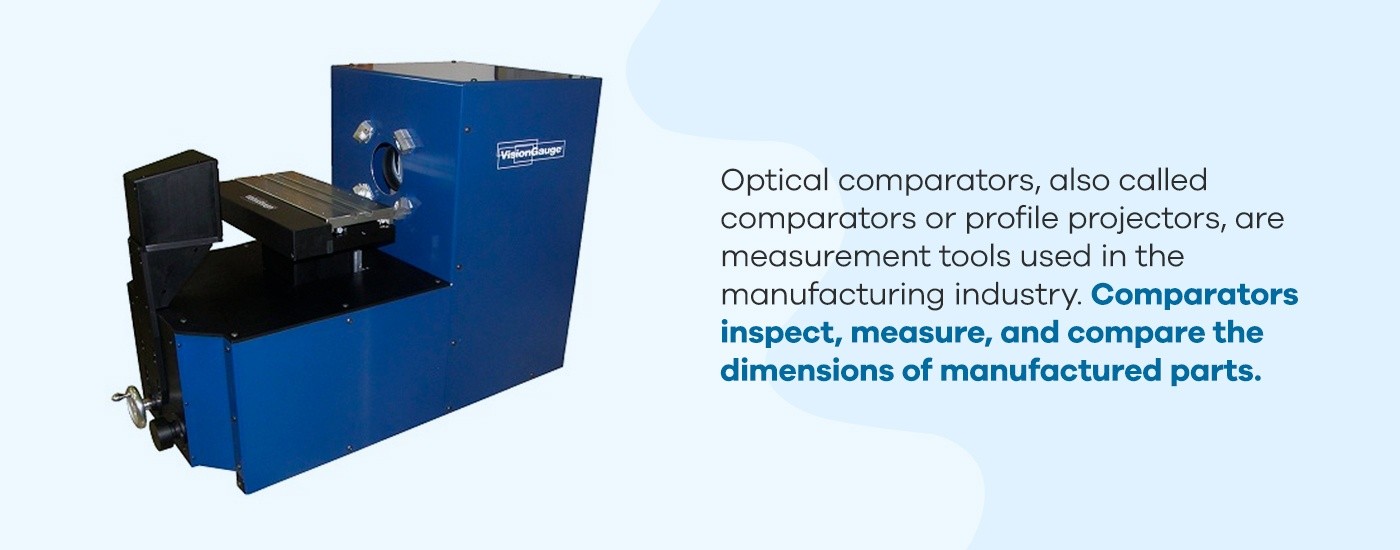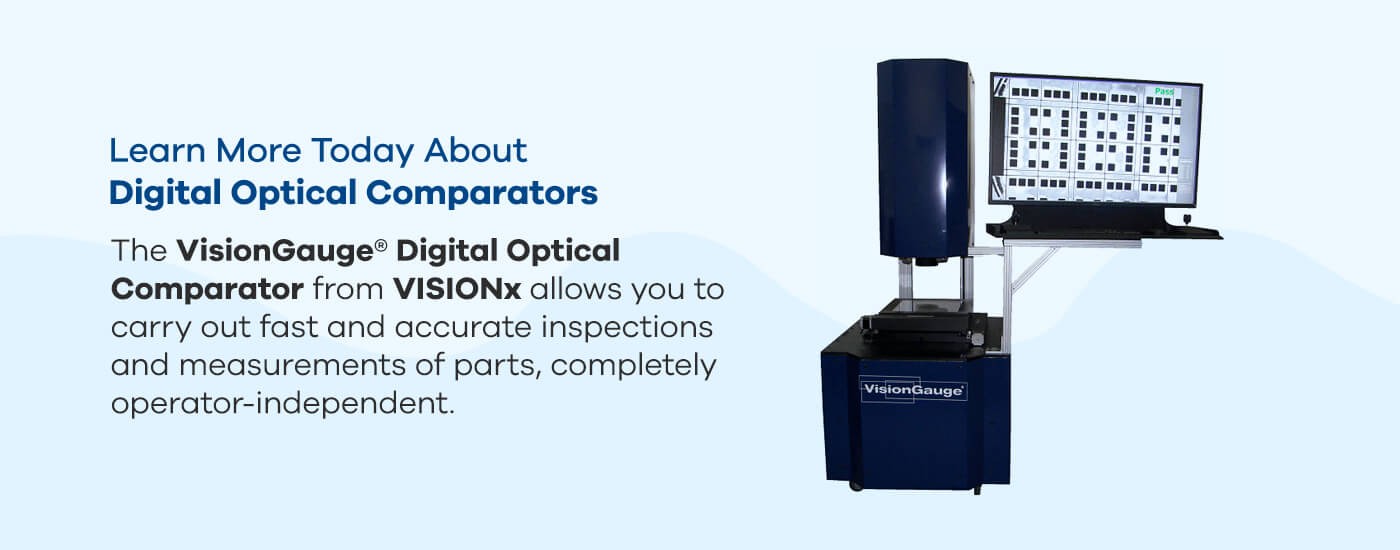Optical comparators are indispensable tools in manufacturing for quality control. At COMPARE.EDU.VN, we delve into the workings of optical comparators, explaining how they provide accurate and reliable measurements. Explore their types, applications, and the benefits they offer in modern manufacturing processes, enhancing dimensional measurement and surface inspection.
1. Understanding Optical Comparators
Optical comparators, also known as profile projectors, are instruments used in manufacturing to inspect and measure the dimensions of parts. They project a magnified image of a part onto a screen, allowing for detailed comparison against specified tolerances. This method facilitates non-contact measurement, minimizing the risk of damage to delicate parts.
1.1. Basic Definition
Optical comparators use optical principles involving illumination, lenses, and mirrors to create a magnified silhouette of a part on a screen. This projection enables the user to compare the part’s dimensions and surface features with a standard or overlay, ensuring it meets the required specifications.
1.2. Key Components of an Optical Comparator
The main components of an optical comparator include:
- Light Source: Provides illumination to create a shadow image of the part.
- Stage: A platform to hold the part in place during inspection.
- Lens System: Magnifies the part’s image and projects it onto the screen.
- Mirrors: Reflect the magnified image onto the screen.
- Screen: Displays the magnified image for comparison and measurement.
1.3. Types of Optical Comparators: Horizontal vs. Vertical
Optical comparators come in two primary configurations: horizontal and vertical.
- Horizontal Comparators: The light travels horizontally, projecting a side view of the part. They are ideal for parts fixed in place, like screws or castings.
- Vertical Comparators: The light travels vertically, providing a top-down view of the part. They are suitable for flat components that can lie on the work stage, such as gaskets.
1.4. Industries That Rely on Optical Comparators
Optical comparators are used across various sectors for quality control. Some of the key industries include:
- Automotive: Ensuring parts meet dimensional accuracy.
- Aerospace: Inspecting critical components for defects.
- Medical Manufacturing: Measuring precision instruments.
- Defense: Verifying the dimensions of military equipment.
- Scientific: Analyzing parts for research and development.
2. How Optical Comparators Work: A Detailed Explanation
The basic principle of an optical comparator involves projecting a magnified image of a part onto a screen for comparison and measurement. Here’s a step-by-step breakdown of the process.
2.1. The Illumination Process
A light source is directed through the stage, where the part is placed. The light creates a shadow image of the part, which is then magnified and projected onto the screen.
2.2. Magnification and Projection
The shadow image passes through a series of lenses and mirrors, magnifying the image and projecting it onto the screen. The magnification level depends on the optics and screen size of the comparator.
2.3. Measurement Techniques
Optical comparators use three primary measurement techniques:
- Silhouette Measurement: Projecting a silhouette of the image onto a screen for direct measurement.
- Point Comparison: Comparing the image’s silhouette to predefined points on a screen.
- Software Analysis: Using digital software to analyze and measure the image electronically.
2.4. Understanding Optical Comparator Overlay
Optical comparator overlays, also known as templates or Mylars, are transparent sheets with scaled drawings of the part. They are placed on the comparator screen to compare the projected image with the drawing, identifying any discrepancies. At COMPARE.EDU.VN, we understand the importance of accurate measurements.
2.5. Setting Up and Calibrating an Optical Comparator
Proper setup and calibration are crucial for accurate measurements. Here are the basic steps:
- Ensure the comparator is placed on a stable surface.
- Turn on the light source and allow it to warm up.
- Place the part on the stage and adjust its position.
- Focus the image using the focusing knob until it is sharp and clear.
- Calibrate the comparator using a known standard to ensure accurate measurements.
3. The Evolution: Traditional vs. Digital Optical Comparators
While traditional optical comparators have been around for decades, digital models offer enhanced capabilities and precision. Understanding the differences between these two types can help in selecting the right tool for specific needs.
3.1. Traditional Optical Comparators: The Basics
Traditional optical comparators use manual methods for measurement. They involve placing a part on the stage, projecting its image onto a screen, and comparing it with an overlay or template.
3.2. Limitations of Traditional Models
Traditional optical comparators have certain limitations:
- Limited Complexity: They are not well-suited for complex parts that require analysis from multiple angles.
- Lower Accuracy: Manual measurement methods can introduce human error.
- Labor Intensive: They can only measure one part at a time, making them inefficient for large quantities.
- 2D Limitations: They can only project 2D images, which can be insufficient for analyzing multiple dimensions simultaneously.
3.3. Digital Optical Comparators: An Overview
Digital optical comparators use software and cameras to analyze and measure parts. They offer automation capabilities, 3D analysis, and improved accuracy.
3.4. Advantages of Digital Optical Comparators
Digital optical comparators offer several advantages:
- Automation: They automate the measurement process, reducing labor and increasing throughput.
- 3D Capabilities: They can analyze parts in all three dimensions using multiple lighting techniques and 3D inspection methods.
- Quantity Management: They can analyze multiple parts automatically without human intervention.
- Accuracy: They eliminate the potential for human error, providing extremely accurate measurements.
3.5. Comparing Traditional and Digital Models: A Detailed Table
| Feature | Traditional Optical Comparators | Digital Optical Comparators |
|---|---|---|
| Measurement Method | Manual comparison with overlays | Automated software analysis |
| Complexity | Limited to simple 2D parts | Suitable for complex 3D parts |
| Accuracy | Lower accuracy due to manual errors | Higher accuracy with automated measurements |
| Labor | Labor-intensive, one part at a time | Automated, can handle multiple parts simultaneously |
| Capabilities | 2D imaging only | 3D imaging and analysis |
| Speed | Slower measurement speed | Faster measurement speed |
| Cost | Lower initial cost | Higher initial cost, but lower long-term labor costs |
| Data Quantifiable | Difficult to quantify data | Provides quantifiable data and detailed analytical reports |
| Flexibility | Limited flexibility | High flexibility and can be programmed for various inspections |
| Maintenance | Simple maintenance | Requires software updates and occasional hardware maintenance |
| Training | Requires basic operator training | Requires specialized software and hardware training |
| Automation | No automation capabilities | Full automation capabilities |
| Image Analysis | Relies on human eye | Uses software and cameras |


4. Using Optical Comparators: A Step-by-Step Guide
Whether using a traditional or digital model, understanding the proper steps for operation is essential for accurate and reliable measurements.
4.1. How to Use a Traditional Optical Comparator
The steps for using a traditional optical comparator include:
- Placement: Turn on the comparator and place the part on the staging area.
- Alignment: Place an overlay on the screen and align it with the part’s image.
- Comparison: Compare the drawing to the image and identify any discrepancies.
4.2. Common Measurement Methods with Traditional Comparators
Common measurement methods include silhouette measurement, point comparison, and using overlays with grids or concentric circles for precise measurements.
4.3. How to Use a Digital Optical Comparator
Using a digital optical comparator involves:
- Placement: Place the part on the staging area.
- Automated Analysis: The system automatically handles alignment and comparison, providing a pass/fail result with analytical data.
4.4. Key Features of Digital Comparator Software
Digital comparator software offers features such as:
- CAD Comparison: Directly referencing CAD drawings of parts for comparison.
- Automated Alignment: Automatically aligning the part with the CAD drawing.
- Data Reporting: Providing detailed data, including measurements, statistics, and pass/fail results.
4.5. Tips for Accurate Measurements
- Ensure the comparator is properly calibrated.
- Use the correct magnification for the part size.
- Keep the comparator clean and free of dust.
- Regularly check and replace the light source.
- Train operators on proper usage and maintenance.
5. Advantages of Optical Comparators in Manufacturing
Optical comparators offer numerous benefits in manufacturing, ensuring quality control, precision, and efficiency.
5.1. Non-Contact Measurement
Optical comparators use non-contact measurement, minimizing the risk of damage to delicate parts. This is particularly important for parts with intricate designs or sensitive surfaces.
5.2. High Precision and Accuracy
Both traditional and digital optical comparators offer high precision and accuracy. Digital models, in particular, eliminate human error, providing extremely reliable measurements.
5.3. Versatility in Applications
Optical comparators can be used in various applications, from measuring small parts to inspecting large components. They are suitable for a wide range of industries, including automotive, aerospace, and medical manufacturing.
5.4. Cost-Effectiveness
While digital models may have a higher initial cost, they can be more cost-effective in the long run due to reduced labor and improved efficiency. Traditional models offer a lower initial cost, making them suitable for small operations.
5.5. Enhanced Quality Control
Optical comparators enable manufacturers to maintain high standards of quality control, ensuring that parts meet the required specifications. This reduces the risk of defects and improves the reliability of finished products.
6. Applications of Optical Comparators Across Industries
Optical comparators are used across various industries to solve different inspection and measurement challenges.
6.1. Automotive Industry
In the automotive industry, optical comparators are used to inspect parts such as gears, pistons, and valves. They ensure that these components meet the required dimensional accuracy, contributing to the overall performance and safety of vehicles.
6.2. Aerospace Industry
The aerospace industry relies on optical comparators to inspect critical components such as turbine blades, engine parts, and structural elements. The high precision and accuracy of these instruments are essential for ensuring the safety and reliability of aircraft.
6.3. Medical Manufacturing
Medical manufacturing uses optical comparators to measure precision instruments such as surgical tools, implants, and medical devices. Accurate measurements are crucial for ensuring the effectiveness and safety of these products.
6.4. Electronics Industry
In the electronics industry, optical comparators are used to inspect small parts such as connectors, microchips, and circuit boards. They ensure that these components meet the required specifications, contributing to the performance and reliability of electronic devices.
6.5. Other Applications
Other applications of optical comparators include:
- Inspecting plastic parts for defects and dimensional accuracy.
- Measuring the dimensions of machined parts in manufacturing.
- Analyzing the surface finish of components.
- Verifying the dimensions of molds and dies.
- Quality control in the production of rubber and silicone products.
7. Future Trends in Optical Comparator Technology
The field of optical comparators is continually evolving, with new technologies and innovations emerging to meet the changing needs of manufacturers.
7.1. Advancements in Digital Imaging
Advancements in digital imaging technology are improving the resolution and accuracy of digital optical comparators. High-resolution cameras and advanced image processing algorithms enable more detailed analysis of parts.
7.2. Integration with Automation Systems
Integration with automation systems is streamlining the measurement process, reducing labor, and increasing throughput. Automated optical comparators can be integrated with robotic systems for automated part handling and inspection.
7.3. Enhanced 3D Measurement Capabilities
Enhanced 3D measurement capabilities are enabling more comprehensive analysis of parts. New technologies such as laser scanning and structured light projection are being integrated into optical comparators for 3D measurement.
7.4. Improved Software and Data Analysis
Improved software and data analysis tools are providing manufacturers with more detailed insights into their processes. Advanced software algorithms can analyze measurement data, identify trends, and provide recommendations for process improvement.
7.5. Miniaturization and Portability
Miniaturization and portability are making optical comparators more accessible to a wider range of users. Compact, portable models can be used in the field for on-site inspection and measurement.
8. Choosing the Right Optical Comparator for Your Needs
Selecting the right optical comparator depends on various factors, including the type of parts being measured, the required accuracy, and the budget.
8.1. Assessing Your Measurement Needs
Start by assessing your measurement needs. Consider the type of parts you will be measuring, the required accuracy, and the volume of parts to be inspected.
8.2. Evaluating Different Models
Evaluate different models based on their features, capabilities, and cost. Compare traditional and digital models, considering the advantages and limitations of each.
8.3. Considering Key Features
Consider key features such as magnification, screen size, measurement methods, and software capabilities. Choose a model that meets your specific needs and offers the features you require.
8.4. Checking for Compatibility
Check for compatibility with existing equipment and software. Ensure that the optical comparator can be easily integrated into your existing processes.
8.5. Reading Reviews and Seeking Recommendations
Read reviews and seek recommendations from other users. This can provide valuable insights into the performance and reliability of different models.
9. Maintaining Your Optical Comparator for Optimal Performance
Proper maintenance is essential for ensuring the optimal performance and longevity of your optical comparator.
9.1. Regular Cleaning
Regular cleaning is important for keeping the comparator free of dust and debris. Use a soft cloth to clean the screen, lenses, and mirrors.
9.2. Checking and Replacing the Light Source
Check the light source regularly and replace it as needed. A dim or flickering light source can affect the accuracy of measurements.
9.3. Calibrating the Comparator Regularly
Calibrate the comparator regularly using a known standard. This ensures that measurements are accurate and reliable.
9.4. Storing the Comparator Properly
Store the comparator in a clean, dry environment. Protect it from dust, moisture, and extreme temperatures.
9.5. Following Manufacturer’s Instructions
Follow the manufacturer’s instructions for maintenance and care. This can help prevent damage and ensure optimal performance.
10. Case Studies: Real-World Applications of Optical Comparators
Real-world case studies demonstrate the practical applications and benefits of optical comparators in various industries.
10.1. Automotive Industry: Improving Gear Quality
An automotive manufacturer used an optical comparator to improve the quality of gears. By inspecting the dimensions of the gears, they were able to identify and correct manufacturing defects, resulting in improved performance and reliability.
10.2. Aerospace Industry: Ensuring Turbine Blade Accuracy
An aerospace company used an optical comparator to ensure the accuracy of turbine blades. The high precision and accuracy of the comparator were essential for meeting the stringent requirements of the aerospace industry.
10.3. Medical Manufacturing: Measuring Surgical Instruments
A medical manufacturing company used an optical comparator to measure surgical instruments. Accurate measurements were crucial for ensuring the effectiveness and safety of the instruments.
10.4. Electronics Industry: Inspecting Microchips
An electronics manufacturer used an optical comparator to inspect microchips. The high-resolution imaging capabilities of the comparator enabled them to identify defects and ensure the quality of the microchips.
10.5. General Manufacturing: Quality Control in Production
A general manufacturing company used an optical comparator for quality control in production. By inspecting parts at various stages of the manufacturing process, they were able to identify and correct defects, reducing waste and improving efficiency.
11. Frequently Asked Questions (FAQs) About Optical Comparators
Here are some frequently asked questions about optical comparators:
11.1. What is an optical comparator?
An optical comparator, also known as a profile projector, is a measurement tool used in manufacturing to inspect and measure the dimensions of parts.
11.2. How does an optical comparator work?
An optical comparator projects a magnified image of a part onto a screen for comparison and measurement. It uses optical principles involving illumination, lenses, and mirrors to create the magnified image.
11.3. What are the different types of optical comparators?
The two primary types of optical comparators are horizontal and vertical models. Horizontal comparators project a side view of the part, while vertical comparators project a top-down view.
11.4. What are the advantages of using an optical comparator?
The advantages of using an optical comparator include non-contact measurement, high precision and accuracy, versatility in applications, and enhanced quality control.
11.5. How do I choose the right optical comparator for my needs?
To choose the right optical comparator, assess your measurement needs, evaluate different models, consider key features, check for compatibility, and read reviews and seek recommendations.
11.6. How do I maintain my optical comparator for optimal performance?
To maintain your optical comparator, perform regular cleaning, check and replace the light source, calibrate the comparator regularly, store the comparator properly, and follow the manufacturer’s instructions.
11.7. What industries use optical comparators?
Optical comparators are used across various industries, including automotive, aerospace, medical manufacturing, and electronics.
11.8. What is the difference between traditional and digital optical comparators?
Traditional optical comparators use manual methods for measurement, while digital optical comparators use software and cameras to analyze and measure parts. Digital models offer automation capabilities, 3D analysis, and improved accuracy.
11.9. How accurate are optical comparators?
Optical comparators can be highly accurate, with digital models offering even greater precision due to automated measurement and analysis.
11.10. Can optical comparators measure 3D parts?
Yes, digital optical comparators can measure 3D parts using multiple lighting techniques, additional positioning stages, and lasers to analyze parts in all dimensions.
12. Conclusion: The Continued Importance of Optical Comparators
Optical comparators continue to be essential tools in manufacturing, providing accurate and reliable measurements for quality control. Whether using traditional or digital models, understanding how these instruments work and their benefits can help manufacturers maintain high standards of quality and efficiency. Visit COMPARE.EDU.VN for more comparisons.
Optical comparators are vital for optical inspection, offering an advanced optical analysis tool that maximizes the function of optical comparator technology. They deliver fast, high-quality results, completely operator-independent. VISIONx, Inc. develops, sells, and supports software, systems, and hardware for automated imaging, visual inspection, and measurement solutions.
For custom or standard solutions in various industries, rely on VISIONx, Inc. Address: 333 Comparison Plaza, Choice City, CA 90210, United States. Whatsapp: +1 (626) 555-9090. Visit compare.edu.vn today to explore and compare optical comparators!
